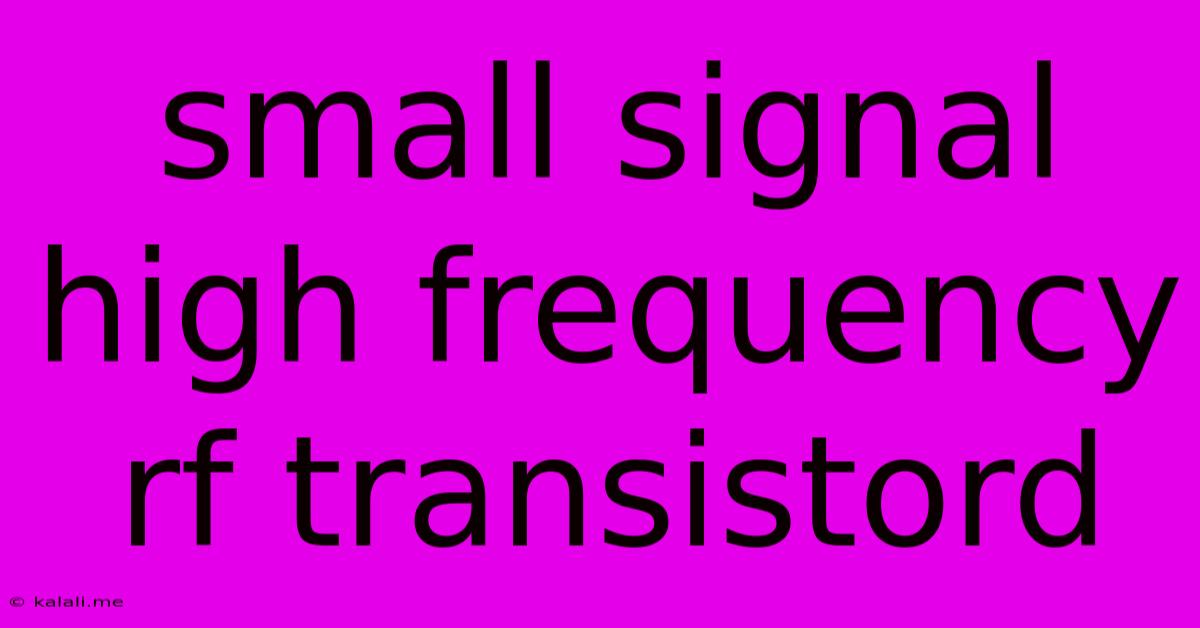Small Signal High Frequency Rf Transistord
Kalali
Jun 07, 2025 · 4 min read

Table of Contents
Small Signal High-Frequency RF Transistors: A Deep Dive
Meta Description: This article explores the intricacies of small-signal high-frequency RF transistors, covering their characteristics, applications, and design considerations. Learn about crucial parameters like cutoff frequency, noise figure, and gain.
High-frequency radio frequency (RF) applications demand transistors capable of operating efficiently at gigahertz frequencies. Small-signal high-frequency RF transistors are essential components in a vast array of modern electronics, from wireless communication systems to radar technology. Understanding their characteristics and limitations is crucial for successful circuit design. This article delves into the key aspects of these specialized transistors.
Understanding the High-Frequency Landscape
At high frequencies, parasitic effects within the transistor become significant. These include:
- Capacitance: Junction capacitances (base-emitter, base-collector, collector-emitter) become increasingly important, impacting both gain and bandwidth. These capacitances act as low-pass filters, limiting the high-frequency response.
- Inductance: Lead inductance and internal inductances within the transistor structure introduce phase shifts and impedance mismatches. These effects can lead to signal distortion and reduced efficiency.
- Transit Time Effects: The time it takes for charge carriers to travel across the transistor's active region becomes a limiting factor at high frequencies. This transit time introduces phase lag and ultimately reduces gain.
Key Parameters of High-Frequency RF Transistors
Several crucial parameters define the performance of a small-signal high-frequency RF transistor:
-
Cutoff Frequency (f<sub>T</sub>): This is the frequency at which the current gain of the transistor drops to unity. A higher f<sub>T</sub> indicates better high-frequency performance. This parameter is essential for determining the transistor's suitability for a given application. It's a critical parameter when considering bandwidth and signal integrity.
-
Maximum Oscillation Frequency (f<sub>max</sub>): This is the frequency at which the transistor's power gain drops to unity. It indicates the highest frequency at which the transistor can be used in an amplifier configuration. f<sub>max</sub> provides insights into the transistor's ability to handle high-frequency signals without significant power loss.
-
Noise Figure (NF): At high frequencies, noise generated within the transistor becomes a major concern. The noise figure quantifies the amount of noise added by the transistor to the signal. A lower noise figure is desirable for applications requiring high sensitivity, such as receivers. Minimizing noise is paramount in achieving optimal signal-to-noise ratio (SNR).
-
Gain: The transistor's gain at the operating frequency is critical. Gain variations across the frequency band must be considered for proper circuit design and matching networks. Understanding gain compression is crucial at higher power levels.
-
Input and Output Impedance: Accurate impedance matching is vital for efficient power transfer and optimal signal integrity. These parameters will vary with frequency.
Transistor Types for High-Frequency Applications
Several transistor types are optimized for high-frequency performance:
-
Heterojunction Bipolar Transistors (HBTs): These transistors offer high f<sub>T</sub> and f<sub>max</sub> due to their improved carrier transport characteristics.
-
High Electron Mobility Transistors (HEMTs): HEMTs exhibit extremely high electron mobility, leading to excellent high-frequency performance. They are commonly used in millimeter-wave applications.
-
MESFETs (Metal-Semiconductor Field-Effect Transistors): MESFETs are widely used in high-frequency circuits, offering good gain and bandwidth.
Design Considerations for High-Frequency Circuits
Designing circuits using small-signal high-frequency RF transistors requires careful attention to several factors:
-
Matching Networks: Impedance matching networks are essential to maximize power transfer and minimize signal reflections. These networks typically use inductors and capacitors to transform impedance at the desired frequencies.
-
Layout: Parasitic effects can significantly impact performance. Careful PCB layout is crucial to minimize lead inductance and unwanted capacitance.
-
Bias Point Selection: Optimizing the transistor's bias point for the desired operating conditions is critical for achieving optimal performance.
-
Thermal Management: High-frequency operation can lead to significant heat generation. Effective thermal management is necessary to prevent device damage and ensure stable operation.
Conclusion
Small-signal high-frequency RF transistors are critical components in a wide range of modern electronic systems. Understanding their key parameters, characteristics, and design considerations is essential for successful high-frequency circuit design. By carefully selecting the appropriate transistor and implementing proper design techniques, engineers can leverage the capabilities of these devices to create high-performance RF systems. The future of high-speed communication and other advanced technologies hinges on continued advancements in these crucial components.
Latest Posts
Latest Posts
-
How Much Cornstarch To Thicken Sauce
Jun 07, 2025
-
How Can You Tell The Difference
Jun 07, 2025
-
Mods Thjat Make Mobs Spawn From The Ground
Jun 07, 2025
-
How To Attach A Hammock To Trees
Jun 07, 2025
-
Best State To Get Divorced In For Men
Jun 07, 2025
Related Post
Thank you for visiting our website which covers about Small Signal High Frequency Rf Transistord . We hope the information provided has been useful to you. Feel free to contact us if you have any questions or need further assistance. See you next time and don't miss to bookmark.